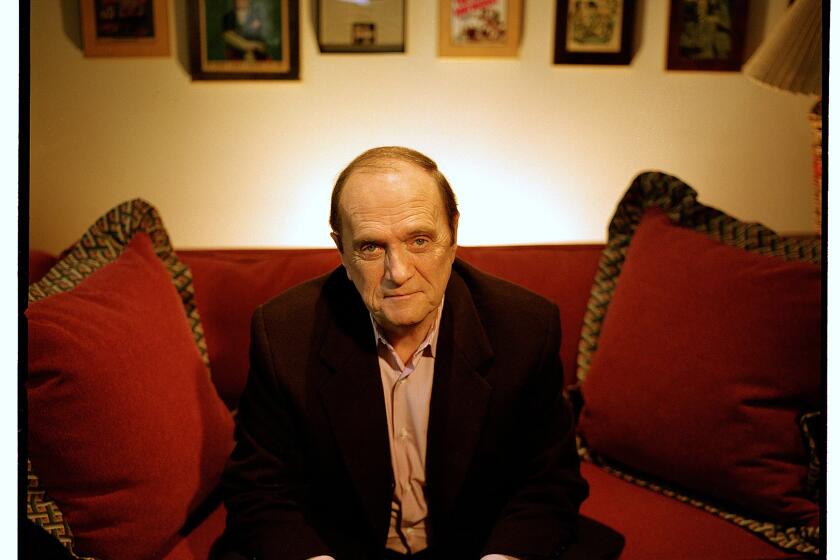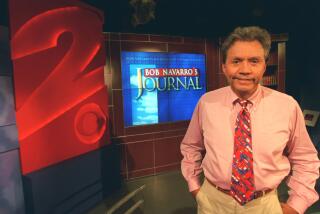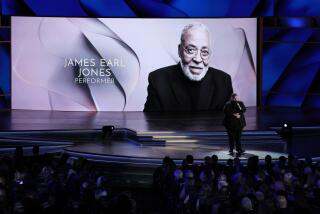Bob Newhart was a timeless comedic genius whose quiet delivery made him a star
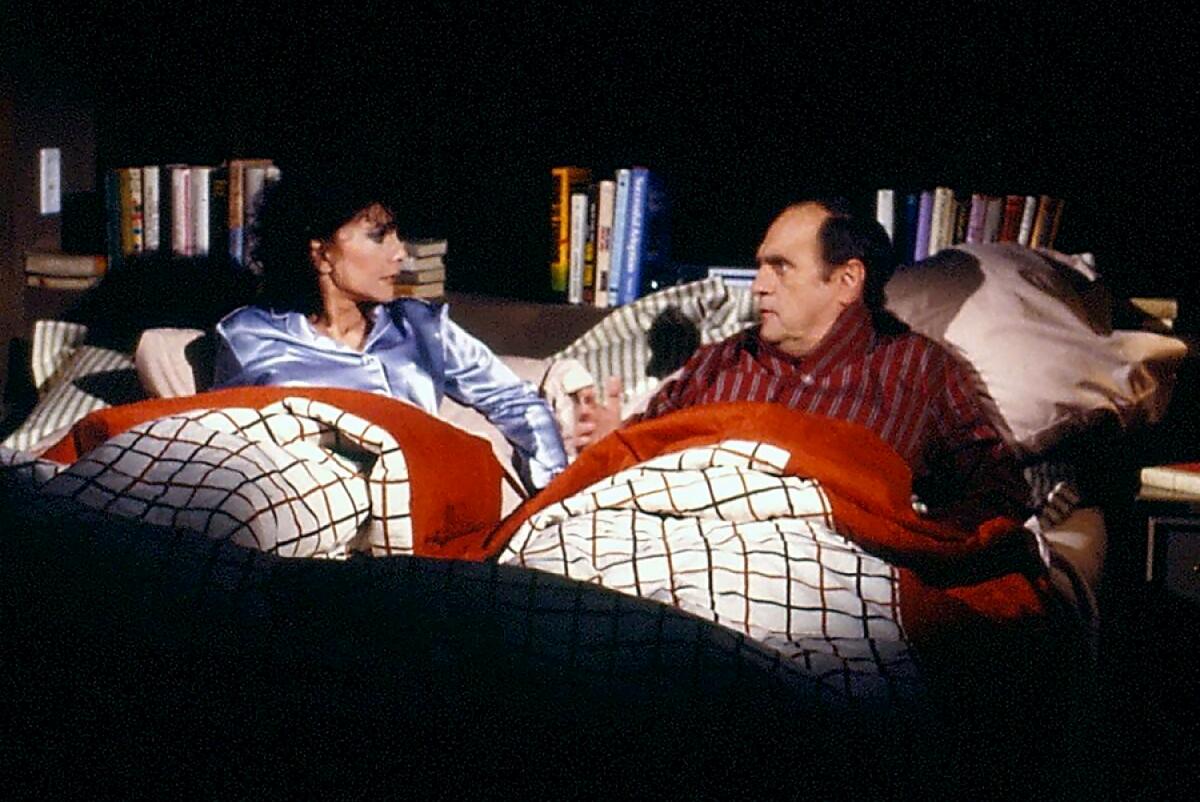
- Share via
The nice thing would be to wake up and find oneself in bed in a Chicago apartment between Bob and Emily, or in a Vermont inn with Dick and Joanna, and find that this was all a dream. Sadly, the world doesn’t work that way. Bob Newhart has left the stage for the last time, and the dream is over.
Newhart, who died Thursday at the age of 94, was a quiet comic giant whose sneaky genius ruled comedy across seven decades and whose name was attached to four fine sitcoms — “The Bob Newhart Show,” “Newhart,” “Bob” and “George and Leo,” his actual first name being George — and a drinking game, “Hi, Bob.” (Pardon me while I sip.)
After a brief, unsuccessful stint selling taped comic routines to radio stations, his first album, “The Button-Down Mind of Bob Newhart,” recorded in 1960 at his first ever public performance, was massively, historically successful: It reached No. 1 on the Billboard charts and won Grammys for album of the year and best new artist. When its follow-up, “The Button-Down Mind Strikes Back!,” was released six months later, Newhart found himself with the No. 1 and No. 2 records in the country.
Bob Newhart, a 1960s stand-up comedy sensation who parlayed his low-key, deadpan style into sitcom gold on ‘The Bob Newhart Show’ and ‘Newhart,’ dies at 94.
In the early 1960s, comics did not tell you about themselves the way they do now; authenticity was not a quality comedy prized. They worked behind created personas, or they presented little playlets — this was as true of Lenny Bruce as it was of Nichols and May or Shelley Berman (who, like Newhart, employed the one-sided phone conversation). They might show you who they were by the way they processed the world into a routine; Newhart estimated that his character “is about 85% me, the other 15% being an extremely … sick mind that enjoys the macabre.” But they wouldn’t draw you a picture.
There is no “I” in Newhart’s classic stand-up, past “I was reading in the paper today” or “I think it might go something like this.” About all you could learn about him from his stage act is that he was from Chicago, worked as an accountant (“I had a kind of strange theory of accountancy — if you got within two or three bucks of it … but it never caught on”) and had a job in the unemployment office until he realized he made only $10 more than his clients, “and they only had to come in once a week.”
Newhart was outwardly, if deceptively, the picture of midcentury American crew-cut, suit-and-tie normalcy — a blank canvas on which he painted his characters. Plausible as a driving instructor or a rocket scientist or Clark Kent trying to get his Superman suit out of the dry cleaners, he would address an implied partner sitting invisibly next to him or on the other end of an imaginary phone line. (“The audience participates,” he told one interviewer, of the gaps the listener filled in. “In terms of McLuhan, it isn’t a cool medium, it becomes a hot medium.”)
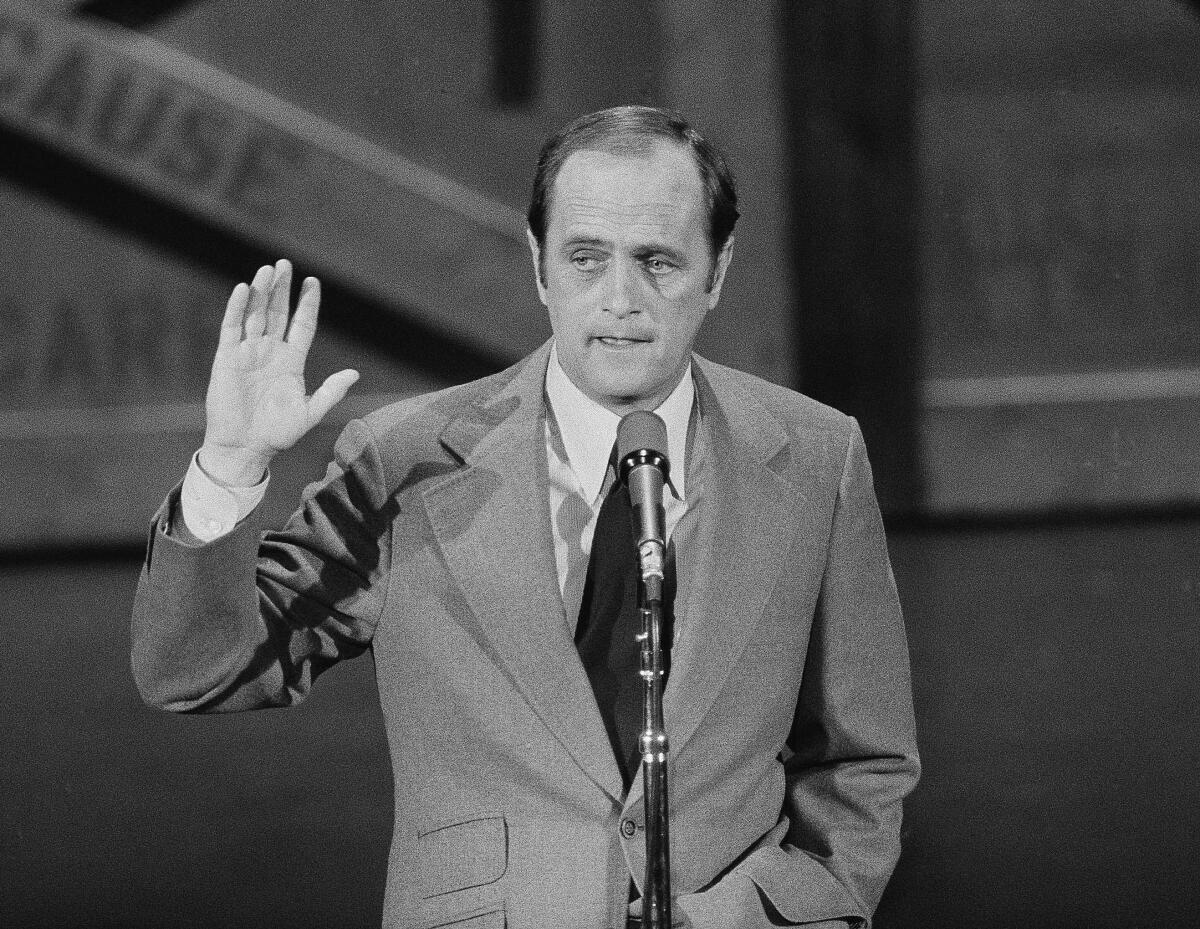
In these routines, he often was calming someone down, or talking them around, or putting a good face on bad news. He’d play a policeman talking a jumper off a ledge (“You know you’re drawing a hell of a crowd for a weekday”), an analyst with Benjamin Franklin as a client (“OK, Ben, let’s see if we can get to the bottom of this kite fixation thing”) or a PR agent counseling Abraham Lincoln before the Gettysburg Address (“You changed four score and seven to 87? Abe, that’s supposed to be a grabber. ... We test-marketed that, and they went out of their minds”). A buffeted but maintained equanimity was the hallmark of his career, from his stand-up work to his situation comedies to his many guest appearances.
His phone shtick was inserted whole into his first film, the 1962 war movie “Hell Is for Heroes,” where he appeared as comic relief alongside Steve McQueen, Bobby Darin and Fess Parker. In order to distract eavesdropping Germans, he pretends to talk on a field telephone to a superior officer: “About the morale, sir, it’s been rather low. The main complaint seems to be about the evening movie … I’ve had to show ‘Road to Morocco’ now five evenings in a row, sir … The men are beginning to get a little surly.”
The cultural impact of a long-running show in the days when three networks owned the air, producing some two dozen episodes a year, cannot be understated. And Newhart had two of them, both on CBS — there are 142 episodes of the impeccable “The Bob Newhart Show,” which ran from 1972 to 1978, where he played psychologist Robert Hartley opposite Suzanne Pleshette, and 184 of “Newhart,” airing from 1982 to 1990, in which he played innkeeper Dick Loudon opposite Mary Frann. (I am a fan as well of the less successful “Bob,” with Newhart as a greeting card artist, and “George and Leo,” which paired him “Odd Couple”-style with Judd Hirsch.) Situation comedies are not just shows to watch but places to go; we live alongside the characters, across time. We react to the comedy so strongly because we know them so well, we know where they’re headed, what they mean. Bob was family.
His mastery of one-sided conversations notwithstanding, “The Bob Newhart Show” demonstrated that its star’s true artistry emerged when he had other actors to play off and react to. Audience expectations meant that there were always phone calls to be made — a drunken call to a Chinese restaurant attempting to order moo goo gai pan is one of the series’ signature moments. In both “The Bob Newhart Show” and “Newhart,” as a comparatively sensible person beset by eccentrics, he could get a lot of mileage out of a simple “Why?” His version of a double take was a blank stare, his weapon the throwaway ironic remark.

Relatively few sitcoms were interested in adult married couples when “The Bob Newhart Show” went on the air, and especially one without the baggage of children. The Hartleys and the Loudons were not without irritation or annoyance in their relationships, but they were attractive, attracted people, sexual by implication. Not only did Bob and Emily share a bed, which was terribly modern for 1972 TV, but the bed was a stage; some of their best comedy was played in it, lying side by side. When “Newhart” suddenly morphed into “The Bob Newhart Show” in its famous final moments, suggesting the entire later series had been Bob Hartley’s dream, it was to that bed it magnetically returned. The studio audience began applauding as soon as the set (which had been kept secret from the cast and crew) was revealed, even before Pleshette rose from beneath the covers.
Apart from late-career dramatic roles, Newhart brought the same comic toolbox to every assignment, whether as Will Ferrell’s adoptive father in the Christmas perennial “Elf” or Jim Parsons’ childhood idol in “The Big Bang Theory.” Because he was choosy, or was lucky enough to work with writers who knew what to do with him, or just because he was so very good, so completely himself, it’s hard to find a dud appearance at any stage of his long career. “Catch-22” might have been an awkward film of the book, but there’s nothing wrong with Newhart’s Maj. Major Major Major.
His timing was exquisite, his delivery musical in a light, dry way. (He did not like to be called “deadpan” or “mild-mannered.”) That he began on the radio, as “a poor man’s Bob & Ray,” perhaps attuned him to the power of the pause, the uses of silence. His natural tendency to stammer — “which I think is a sign of intelligence but I can find no evidence that supports that” — was built into his stop-start delivery. A breath taken before the end of a sentence would turn the final word into a firecracker.
More to Read
The complete guide to home viewing
Get Screen Gab for everything about the TV shows and streaming movies everyone’s talking about.
You may occasionally receive promotional content from the Los Angeles Times.
